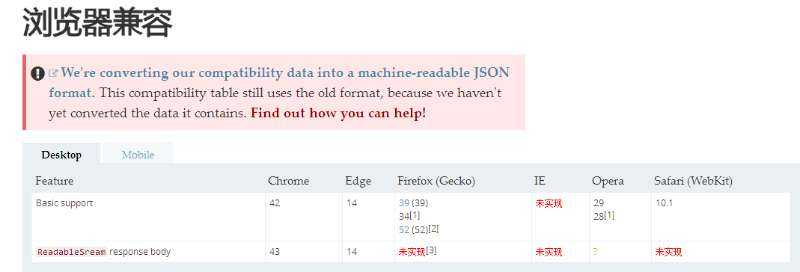一、fetch 是 XMLHttpRequest 的替代方案。说白了就是除了 ajax 获取后台数据之外也可以用fetch 来获取。
二、fetch 的支持性还不是很好。挂载于BOM中可以通过浏览器直接访问。
1.支持情况

当然,如果不支持fetch也没有问题,可以使用第三方的ployfill来实现只会fetch:whatwg-fetch
三、JSON-SERVER模拟后台接口
1.初始化项目 npm init
2.安装JSON-SERVER: npm install --save-dev json-server
3.在跟目录下面创建一个db.json 写入
{
"posts": [
{ "id": 1, "title": "json-server", "author": "typicode" }
],
"comments": [
{ "id": 1, "body": "some comment", "postId": 1 }
],
"profile": { "name": "typicode" }
}
4.在package.json 中添加一段代码
"scripts": { "server": "json-server db.json", // 新加行 "test": "..." }
5.npm run server

三个接口已经生成,支持post(新增) delete(删除) put(修改) get(查询);
关于JSON-SERVER 其他的配置我就不说了。有兴趣的自己去官网查看下。目前只是模拟一个后台接口。
四、GET请求。
1.
fetch(‘http://10.63.68.93:3000/profile‘, { method: ‘GET‘ }).then((res)=>{ return res.json() }).then(res => { console.log(res) //Object {name: "typicode"} })
2.get 请求参数的传递
把参数带在URL上面
fetch(‘http://10.63.68.93:3000/profile?a=2&b=1‘, { method: ‘GET‘ }).then((res)=>{ return res.json() }).then(res => { console.log(res) //Object {name: "typicode"} })
五、POST请求
1.与GET请求类似,POST请求的指定也是在fetch的第二个参数中:
fetch(‘http://10.63.68.93:3000/comments‘, { method: ‘POST‘ }).then((res)=>{ return res.json() }).then(res => { console.log(res) //Object {name: "typicode"} })
2.POST请求的参数传递
var paramsString = "q=URLUtils.searchParams&topic=api" var searchParams = new URLSearchParams(paramsString); fetch(‘http://10.63.68.93:3000/posts‘, { method: ‘POST‘, body: searchParams // 这里是请求对象 具体api 去看fetch 官网的 URLSearchParams }).then((res)=>{ return res.json() }).then(res => { console.log(res) })
六、设置请求头
let myHeaders = new Headers(); myHeaders.append(‘Content-Type‘, ‘text/xml‘); myHeaders.get(‘Content-Type‘); // should return ‘text/xml‘
var paramsString = "q=URLUtils.searchParams&topic=api" var searchParams = new URLSearchParams(paramsString); let myHeaders = new Headers(); myHeaders.append(‘Content-Type‘, ‘text/xml‘); myHeaders.get(‘Content-Type‘); /* myHeaders = new Headers({ "Content-Type": "text/plain", "Content-Length": content.length.toString(), "X-Custom-Header": "ProcessThisImmediately", }); */ // should return ‘text/xml‘ fetch(‘http://10.63.68.93:3000/posts‘, { method: ‘POST‘, headers:myHeaders, body: searchParams // 这里是请求对象 具体api 去看fetch 官网的 URLSearchParams }).then((res)=>{ return res.json() }).then(res => { console.log(res) })
七、强制带cookie
默认情况下, fetch 不会从服务端发送或接收任何 cookies, 如果站点依赖于维护一个用户会话,则导致未经认证的请求(要发送 cookies,必须发送凭据头).
八、fetch 封装ajax请求
/** * 将对象转成 a=1&b=2的形式 * @param obj 对象 */ function obj2String(obj, arr = [], idx = 0) { for (let item in obj) { arr[idx++] = [item, obj[item]] } return new URLSearchParams(arr).toString() } /** * 真正的请求 * @param url 请求地址 * @param options 请求参数 * @param method 请求方式 */ function commonFetcdh(url, options, method = ‘GET‘) { const searchStr = obj2String(options) let initObj = {} if (method === ‘GET‘) { // 如果是GET请求,拼接url url += ‘?‘ + searchStr initObj = { method: method, credentials: ‘include‘ } } else { initObj = { method: method, credentials: ‘include‘, headers: new Headers({ ‘Accept‘: ‘application/json‘, ‘Content-Type‘: ‘application/x-www-form-urlencoded‘ }), body: searchStr } } fetch(url, initObj).then((res) => { return res.json() }).then((res) => { return res }) } /** * GET请求 * @param url 请求地址 * @param options 请求参数 */ function GET(url, options) { return commonFetcdh(url, options, ‘GET‘) } /** * POST请求 * @param url 请求地址 * @param options 请求参数 */ function POST(url, options) { return commonFetcdh(url, options, ‘POST‘) }
